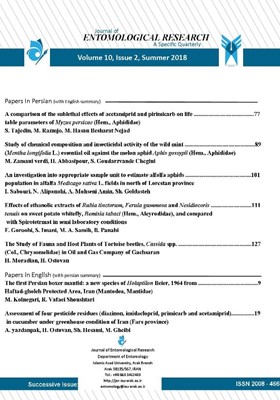-
-
List of Articles
-
Open Access Article
1 - A comparison of the effects of sublethal Loses of Acetamiprid and Pirimicarb on life table parameters of Myzus persicae (Hem.: Aphididae)
S. Tajedin M. Razmjo M. H. Besharat Nejad -
Open Access Article
2 - Study on the chemical composition and insecticidal activity of the wild mint (Mentha longifolia L.) essential oil against the melon aphid (Aphis gossypii Glover)
M. Zamani verdi H. Abbasipour S. Goudarzvande Chegini -
Open Access Article
3 - Estimating an appropriate sample unit for sampling programs of alfalfa aphids in alfalfa fields
]. Sabouri A. Mohseni Amin Sh. Goldasteh N. Alipanahi -
Open Access Article
4 - Effects of ethanolic extracts of Rubia tinctorum, Ferula gummosa and Nesidiocoris tenuis (Hem.: Miridae) on sweet potato whitefly, Bemisia tabaci (Hem.: Aleyrodidae), and comparison with Spirotetrmat
فاطمه Goroohi S. Imani M. A. Samih B. Panahi -
Open Access Article
5 - Study on the fauna and host plants of tortoise beetles, Cassida spp. (Col.: Chrysomelidae) in Gachsaran
H. Ostovan H. Moradian -
Open Access Article
6 - Assessment of four pesticide residues (diazinon, imidacloprid, primicarb and acetamiprid) in cucumber under greenhouse condition of Iran (Fars province)
H. Ostovan A. yazdanpak Sh. Hesami M. Gheibi -
Open Access Article
7 - The first Persian boxer mantid: a new species of Holaptilon Beier, 1964 from Haftad-gholeh Protected Area, Iran (Mantodea, Mantidae)
M. Kolnegari R. Vafaie
-
The rights to this website are owned by the Raimag Press Management System.
Copyright © 2021-2025







